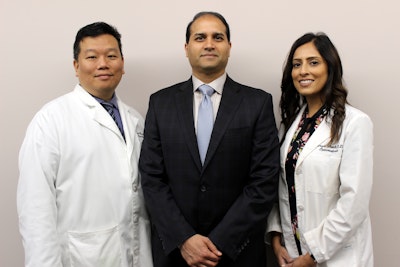
Presbyopia
After age 40, reading small print on phones and books can become increasingly difficult.
Age-related farsightedness is called presbyopia, and it develops as the crystalline lens of the eye begins losing flexibility.
So how can I tell if I have presbyopia?

Presbyopia Symptoms
Trouble Focusing on Close Objects
Vision becomes increasingly blurred and unfocused at normal reading distances.
Holding Objects at Arm’s Length
In order to compensate, many find themselves holding smartphones, books, and other reading material farther from their eyes.
Eyestrain after Reading
After the onset of presbyopia, reading or detail work can leave you with headaches and fatigue due to eyestrain.
Age Is the Most Significant Risk Factor
Presbyopia most commonly affects those age 40 and older. However, certain medical conditions, such as diabetes or cardiovascular diseases, can increase the risk of developing presbyopia earlier.
You may also face a greater risk of developing presbyopia prematurely if:
- You are female
- Have undergone intraocular surgery
- Drink heavily
- Use medications such as antidepressants, antihistamines, or diuretics
- Have suffered ocular trauma
What Causes Age-Related Farsightedness?
The Role of the Crystalline Lens
The crystalline lens lies directly behind the iris. It focuses light onto the retina.
Flexibility Allows Focus
A young and healthy crystalline lens is flexible, allowing it to adjust in order to focus on close objects.
A Rigid Lens Compromises Close Focus
Over time, the proteins that comprise the lens become rigid. While the exact mechanism that causes presbyopia is not known, this loss of flexibility results in difficulty reading books, phones, and computer screens.
Uncorrected presbyopia is the most common cause of visual impairment. “Towards Better Estimates of Uncorrected Presbyopia” (Brien Holden Vision Institute, Bulletin of the World Health Organization)
Can I Prevent Presbyopia?
Delay is the Way
Unfortunately, there is no known way to prevent presbyopia. However, you can take certain measures to avoid premature development of the condition.
Controlling Chronic Health Issues
Health conditions such as diabetes and high blood pressure can take a toll on your vision over time. By managing these conditions, you can prolong your ability to focus on close objects.
Protecting your eyes
It is essential that patients protect their eyes from ultraviolet light and trauma. Sunglasses and specially designed eyewear can provide significant protection.
Checking for Presbyopia with a Basic Eye Exam
Refraction Assessment: Patients are asked to look through a series of lenses to determine which provides the best focus.
/https://d1l9wtg77iuzz5.cloudfront.net/assets/5625/228667/original.jpg?1524514374)
If tests reveal farsightedness, your doctor can determine if this is due to the crystalline lens or the shape of your eye.
Dilation and Exam: After evaluating your vision, the doctor can then dilate the pupils to examine the crystalline lens and other structures within the eye.
Treatment Options
Glasses
Depending on your needs, your doctor may recommend reading glasses.
Contact Lenses
Contacts can be used to achieve monovision, in which one eye is designated for close focus while the other is responsible for distance focus. Many patients adjust to this solution in a way that eliminates or minimizes the need for glasses.
Intraocular Lenses
In severe cases, the doctor may recommend completely exchanging the crystalline lens with an intraocular lens (IOL). Some IOL patients experience unwanted glare, and reading glasses may still be necessary for some tasks.
Talk to Your Doctor Today
Talk to your doctor today if you believe you are experiencing any changes in your vision. When presbyopia begins to present, there are a number of solutions that can counteract the effects of the condition and allow you to read menus, newspapers, and text messages without difficulty.







